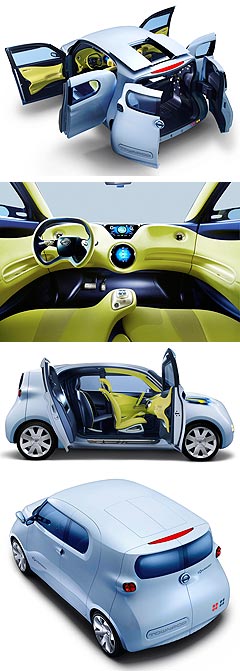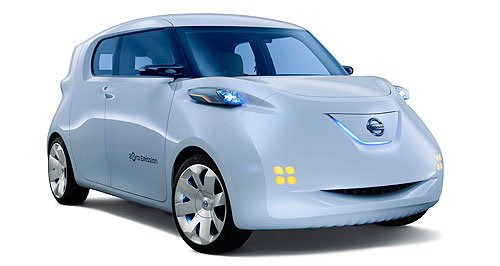Future models - Nissan - TownpodParis show: Nissan’s functional, but chic, TownpodSmarter than it looks: The Townpod's navigation system will double as a personal organiser, mapping out a plan for all the driver's daily appointments. Nissan takes the covers off its Leaf-based van concept aimed at entrepreneurs1 Oct 2010 By TERRY MARTIN WHILE Nissan has been short on detail and longwinded on the descriptions and motivations behind its star Paris concept, the all-electric Townpod begs to be explored further with its clever packaging, smart design and, on the face of it, one of the most appealing blends of passenger car and light commercial vehicle seen to date. As the teaser image and pre-show publicity prompted us to suggest, the Townpod looks to be a precursor to – or at least a potential derivative of – a light all-electric production van that Nissan president Carlos Ghosn vowed would be one of the models that would broaden the application of the company’s EV powertrain beyond the Leaf small car.  A sketch of this van presented at last October’s Tokyo motor show pointed to a more production-oriented vehicle than the Townpod, which has been confirmed as employing the same all-electric drivetrain as the Leaf but is unequivocally aimed at work-at-home entrepreneurs who have blurred lines between their business and social lives. A sketch of this van presented at last October’s Tokyo motor show pointed to a more production-oriented vehicle than the Townpod, which has been confirmed as employing the same all-electric drivetrain as the Leaf but is unequivocally aimed at work-at-home entrepreneurs who have blurred lines between their business and social lives.That translates to a vehicle with plenty of mod-cons and aesthetic appeal in addition to more utilitarian features, and although it comes finished in ‘Stratosphere White’ paint the Townpod is really the antithesis of whitegoods on wheels. “Just as a white T-shirt is usually worn casually, but can be combined with a suit to look sharp, this genre-busting vehicle mixes the comfort and style of a passenger car with the business-like utility of a commercial vehicle,” Nissan says. “Like the T-shirt, Nissan Townpod can be used for business or pleasure or, as is increasingly popular, by those for whom business is pleasure.” The exterior has obvious design links with the Leaf and also brings the Nissan Cube to mind, while the designers point to a Z coupe-like bonnet line and body proportions that hark back to the rat-rods of the 1950s. Just like the Leaf, one of the charging points is behind the Nissan badge on the Townpod’s nose, while other practical elements include headlights doubling as position markers, a hatch-like sunroof over the cargo area allowing tall objects to be carried, and the use of a van-like split tailgate with hinges that enable each portion to slide around to the side of the vehicle. The interior is described as a simple platform that allows owners to customise according to their occupation and particular needs. It is said to be much more spacious than the compact exterior suggests, while the cargo area, passenger compartment and dashboard are deliberately uncluttered. Access to the rear seating area is aided by the absence of a B-pillar, which leaves a wide area free for convenient entry/egress, while the rear bench seat can fold and slide into the back of the front seats to free up the entire space behind to carry extra cargo. Careful placement of cabin trim is also noticed – soft artificial suede in the front compartment and “super-light yet hard-wearing blue weave” in the rear, for example – while the designers have developed a rubber ball with a wide groove cut into it (dubbed the ‘puck’) that can accommodate drink holders, mobile phone rests, handbag hooks and so on. The pucks slot into rounded troughs set into the car's dashboard, doors and centre console, with Nissan emphasising that “their position and orientation are ultimately decided by the user, not the car’s designers”. The driver is faced with a futuristic steering wheel, some conventional switchgear and “a flowing dashboard devoid of mechanical switches”. Forward drive and reverse is selected using a joystick set into the right-hand side of the driver’s seat base, while controls for ancillary functions such as climate control and media playback are accessed through two centrally mounted digital screens, with the system also fitted with Bluetooth wireless tech that enables interaction with the driver’s Personal Digital Assistant (PDA). Nissan product chief designer Masato Inoue said this communication with the PDA eliminates the need to program the car’s navigation unit with a phone number, address or other details – as tends to be the case now – and instead enables the car to automatically hook in with the PDA’s scheduling function. “Accordingly, the navigation system will not only plot a route to your next meeting, but will map out a plan for all your appointments that day,” he said. “If, due to unexpected traffic delays for example, one appointment appears likely to clash with another, the car will let you know so you can take appropriate action. It will also be able to suggest the most convenient time and place for you to recharge its lithium-ion batteries.”  Read more13th of September 2010  Nissan teases with new Paris conceptTownpod targets stay-at-home workers with new electric car conceptAll future models Alfa Romeo Alfa Romeo Abarth Abarth Alpine Alpine Alpina Alpina Audi Audi Aston Martin Aston Martin BMW BMW Bentley Bentley Chery Chery Brabham Brabham Chrysler Chrysler Chevrolet Chevrolet Cupra Cupra Citroen Citroen DS DS Dodge Dodge Fiat Fiat Ferrari Ferrari Foton Foton Ford Ford Great Wall Great Wall FPV FPV Haval Haval GWM GWM Honda Honda Holden Holden Hummer Hummer HSV HSV Infiniti Infiniti Hyundai Hyundai Jaguar Jaguar Isuzu Isuzu Kia Kia Jeep Jeep Land Rover Land Rover Lamborghini Lamborghini Lexus Lexus LDV LDV Mahindra Mahindra Lotus Lotus Mazda Mazda Maserati Maserati Mercedes-AMG Mercedes-AMG McLaren McLaren MG MG Mercedes-Benz Mercedes-Benz Mitsubishi Mitsubishi Mini Mini Opel Opel Nissan Nissan Peugeot Peugeot Pagani Pagani Proton Proton Porsche Porsche Renault Renault Ram Ram Rover Rover Rolls-Royce Rolls-Royce Skoda Skoda Saab Saab SsangYong SsangYong Smart Smart Suzuki Suzuki Subaru Subaru Toyota Toyota Tesla Tesla Volvo VolvoMotor industry news |
Click to shareNissan modelsResearch Nissan All future models Alfa Romeo Alfa Romeo Abarth Abarth Alpine Alpine Alpina Alpina Audi Audi Aston Martin Aston Martin BMW BMW Bentley Bentley Chery Chery Brabham Brabham Chrysler Chrysler Chevrolet Chevrolet Cupra Cupra Citroen Citroen DS DS Dodge Dodge Fiat Fiat Ferrari Ferrari Foton Foton Ford Ford Great Wall Great Wall FPV FPV Haval Haval GWM GWM Honda Honda Holden Holden Hummer Hummer HSV HSV Infiniti Infiniti Hyundai Hyundai Jaguar Jaguar Isuzu Isuzu Kia Kia Jeep Jeep Land Rover Land Rover Lamborghini Lamborghini Lexus Lexus LDV LDV Mahindra Mahindra Lotus Lotus Mazda Mazda Maserati Maserati Mercedes-AMG Mercedes-AMG McLaren McLaren MG MG Mercedes-Benz Mercedes-Benz Mitsubishi Mitsubishi Mini Mini Opel Opel Nissan Nissan Peugeot Peugeot Pagani Pagani Proton Proton Porsche Porsche Renault Renault Ram Ram Rover Rover Rolls-Royce Rolls-Royce Skoda Skoda Saab Saab SsangYong SsangYong Smart Smart Suzuki Suzuki Subaru Subaru Toyota Toyota Tesla Tesla Volvo VolvoMotor industry news |
















Facebook Twitter Instagram